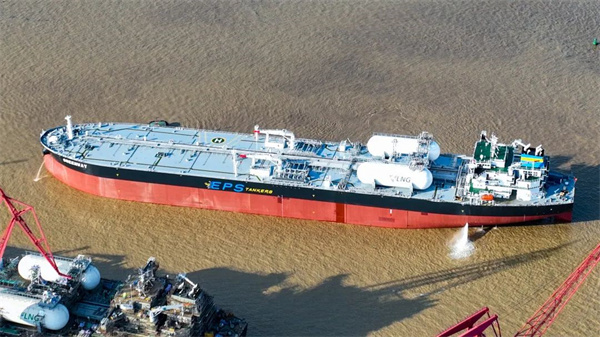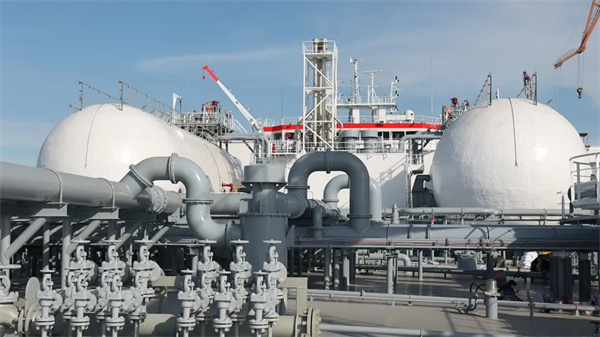GREENWAY, the world's first dual-fuel liquefied natural gas (LNG) Suezmax crude oil tanker, has been delivered to its buyer.
Designed and built by China State Shipbuilding Corporation Limited (CSSC), the tanker is about 274 meters long and 48 meters wide and has a carrying capacity of 158,000 DWT. It is by far the largest dual-fuel LNG green tanker ever built in South China.
It can travel as fast as 14.2 knots.

A view of GREENWAY, the world's first dual-fuel liquefied natural gas (LNG) Suezmax crude oil tanker [Photo/sasac.gov.cn]
Powered by oil and gas, the tanker meets the Tier III emission standards set by the International Maritime Organization (IMO) and when it is propelled by LNG, emissions of carbon dioxide and oxynitride will be reduced by about 20 and 85 percent respectively.
The main engine is installed with a high-pressure selective catalytic reduction (SCR) system that can add nitrogen-containing compounds and etc., into the exhaust emissions to reduce the oxynitride to nitrogen and water. The process makes the tanker meet the world's strictest emission requirements.

A view of the high-pressure selective catalytic reduction (SCR) system installed on the main engine of GREENWAY [Photo/sasac.gov.cn]
The tanker was built by CSSC’s Guangzhou Shipyard International Company Limited, which will shoulder construction of another tanker of the same type.
According to CSSC, Guangzhou Shipyard International Company Limited is now the tanker manufacturer that owns the most tanker types and series in the world. With years of devotion to clean-power vessels, the company has delivered China's first thousand-ton electric ship for inland water and methane dual-fuel MR-type oil tanker, and South China's first LNG dual-fuel product oil tanker. It is now working on the world’s first four-wheel drive hybrid luxury ro-ro ship.
At present, the company has orders of more than 70 vessels valued at over 50 billion yuan ($7.46 billion). Nearly 40 of the orders, valued at about 20 billion yuan, are for the new-type dual-fuel green vessels.
(Executive editor: Wang Ruoting)